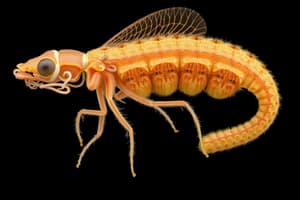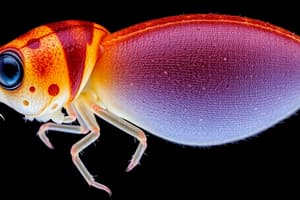Podcast
Questions and Answers
Which of these is NOT a characteristic of archaebacteria?
Which of these is NOT a characteristic of archaebacteria?
- They contain ether-linked lipids
- They can survive in harsh environments
- They have unique enzymes for transcription and translation
- They have cell walls made of peptidoglycan (correct)
Endospores are structures produced by bacteria under favorable environmental conditions.
Endospores are structures produced by bacteria under favorable environmental conditions.
False (B)
What is the primary function of methanogens?
What is the primary function of methanogens?
Production of methane
The process of acquiring free DNA fragments from the environment is called ______.
The process of acquiring free DNA fragments from the environment is called ______.
Match the following terms with their correct definitions:
Match the following terms with their correct definitions:
Which of the following is a benefit of horizontal gene transfer in bacteria?
Which of the following is a benefit of horizontal gene transfer in bacteria?
Fungi are heterotrophic, meaning they can produce their own food through photosynthesis.
Fungi are heterotrophic, meaning they can produce their own food through photosynthesis.
What is the name of the thread-like structures that make up the fungal body?
What is the name of the thread-like structures that make up the fungal body?
The symbiotic relationship between fungi and plant roots is called ______.
The symbiotic relationship between fungi and plant roots is called ______.
Which of the following is NOT a way that plants benefit humans?
Which of the following is NOT a way that plants benefit humans?
Which of the following is NOT one of the 8 common characteristics of all living things?
Which of the following is NOT one of the 8 common characteristics of all living things?
Taxonomy is the scientific practice of classifying organisms based solely on their physical traits.
Taxonomy is the scientific practice of classifying organisms based solely on their physical traits.
Name the five kingdoms of life as classified in modern taxonomy.
Name the five kingdoms of life as classified in modern taxonomy.
The kingdom that includes true bacteria found in most environments is called ______.
The kingdom that includes true bacteria found in most environments is called ______.
Match the following terms with their definitions:
Match the following terms with their definitions:
Which of the following statements is true regarding binomial nomenclature?
Which of the following statements is true regarding binomial nomenclature?
Archaebacteria are found in extreme environments.
Archaebacteria are found in extreme environments.
What is the purpose of a dichotomous key?
What is the purpose of a dichotomous key?
Which part of a bacterial cell is primarily responsible for movement?
Which part of a bacterial cell is primarily responsible for movement?
Eukaryotes have a defined nucleus and membrane-bound organelles.
Eukaryotes have a defined nucleus and membrane-bound organelles.
What is the role of the plasma membrane in bacterial cells?
What is the role of the plasma membrane in bacterial cells?
An organism that can live with or without oxygen is called a ______.
An organism that can live with or without oxygen is called a ______.
Match the bacterial shapes with their definitions:
Match the bacterial shapes with their definitions:
What is the primary function of plasmids in bacterial cells?
What is the primary function of plasmids in bacterial cells?
All prokaryotes are multicellular organisms.
All prokaryotes are multicellular organisms.
What is binary fission?
What is binary fission?
The outer membrane in Gram-negative bacteria protects the cell from ______.
The outer membrane in Gram-negative bacteria protects the cell from ______.
Which of the following statements best describes a cladogram?
Which of the following statements best describes a cladogram?
Derived characteristics are traits that evolved from a common ancestor.
Derived characteristics are traits that evolved from a common ancestor.
What is the function of ribosomes in bacterial cells?
What is the function of ribosomes in bacterial cells?
The process of transferring plasmids between bacterial cells through direct contact is called ______.
The process of transferring plasmids between bacterial cells through direct contact is called ______.
Match the following terms with their characteristics:
Match the following terms with their characteristics:
Flashcards
Taxonomy
Taxonomy
The science of classifying organisms into groups based on shared characteristics and evolutionary relationships.
Seven Levels of Taxa
Seven Levels of Taxa
A system of classifying organisms into seven hierarchical levels, from broadest to most specific: Kingdom, Phylum, Class, Order, Family, Genus, Species.
Kingdom
Kingdom
The broadest taxonomic level grouping similar life forms together based on their shared fundamental characteristics.
Binomial Nomenclature
Binomial Nomenclature
Signup and view all the flashcards
Dichotomous Key
Dichotomous Key
Signup and view all the flashcards
Characteristics of Life
Characteristics of Life
Signup and view all the flashcards
Species
Species
Signup and view all the flashcards
Phylum
Phylum
Signup and view all the flashcards
Transformation
Transformation
Signup and view all the flashcards
Endospore
Endospore
Signup and view all the flashcards
Antibiotic Resistance
Antibiotic Resistance
Signup and view all the flashcards
Halophile
Halophile
Signup and view all the flashcards
Extreme Thermophile
Extreme Thermophile
Signup and view all the flashcards
Psychrophile
Psychrophile
Signup and view all the flashcards
Heterotrophic Nutrition
Heterotrophic Nutrition
Signup and view all the flashcards
Mycelium
Mycelium
Signup and view all the flashcards
Fruiting Body
Fruiting Body
Signup and view all the flashcards
Mycorrhizae
Mycorrhizae
Signup and view all the flashcards
Spider Key
Spider Key
Signup and view all the flashcards
Go-To Key
Go-To Key
Signup and view all the flashcards
Cladogram
Cladogram
Signup and view all the flashcards
Nodes
Nodes
Signup and view all the flashcards
Clades
Clades
Signup and view all the flashcards
Outgroup
Outgroup
Signup and view all the flashcards
Derived Characteristics
Derived Characteristics
Signup and view all the flashcards
Ancestral Traits
Ancestral Traits
Signup and view all the flashcards
Prokaryotes
Prokaryotes
Signup and view all the flashcards
Eukaryotes
Eukaryotes
Signup and view all the flashcards
Pili
Pili
Signup and view all the flashcards
Plasmid
Plasmid
Signup and view all the flashcards
Cytoplasm
Cytoplasm
Signup and view all the flashcards
Plasma membrane
Plasma membrane
Signup and view all the flashcards
Peptidoglycan layer
Peptidoglycan layer
Signup and view all the flashcards
Study Notes
Classification of Living Things
- All living things share eight characteristics:
- Composed of cells and DNA
- Capable of reproduction
- Exhibit ordered organization
- Can grow and develop
- Obtain and use energy
- Respond to stimuli
- Maintain homeostasis
- Evolve over time
Taxonomy
- Taxonomy is the science of classifying organisms.
- Kingdoms are hierarchical levels used in taxonomy.
- Discovering new kingdoms depends on exploring new environments (sea, space, microscopes).
Current Kingdoms
- Animalia (animals)
- Plantae (plants)
- Fungi (mushrooms, molds, yeasts)
- Protista (single-celled organisms like algae)
- Eubacteria (true bacteria)
- Archaebacteria (ancient bacteria in extreme environments)
Taxonomic Levels
- The seven taxonomic levels (KPCOFGS):
- Kingdom
- Phylum
- Class
- Order
- Family
- Genus
- Species
Importance of Taxonomy
- Organizes and classifies organisms.
- Creates a universal language for scientists.
- Helps understand evolutionary relationships.
Binomial Nomenclature
- Assigns unique scientific names to each species.
- Prevents confusion between common names in different languages.
- Examples:
- Grey wolf: Canis lupus
- Potato: Solanum tuberosum
- Water buffalo: Bubalus bubalis
- Brain-eating amoeba: Naegleria fowleri
- Goliath bird-eating spider: Theraphosa blondi
- Examples:
Dichotomous Keys
- Used to identify organisms.
- Consist of a series of choices (yes/no or true/false).
- Example of a dichotomous key (using fictitious organisms):
-
- Has pointed ears...go to 3; Has rounded ears...go to 2
-
- Has no tail...Kentuckyus; Has tail...Dakotus
-
- Ears point upward...go to 5; Ears point downward...go to 4
-
- Example of a dichotomous key (using fictitious organisms):
Cladograms
- Diagrams showing evolutionary relationships based on shared traits.
- Branches represent lineages.
- Nodes represent common ancestors.
- Root represents the most recent common ancestor.
- Clade includes an ancestor and all its descendants, sharing derived traits.
- Outgroup is used to identify evolutionary paths.
- Derived characteristics are traits unique to a clade.
- Ancestral characteristics are found in the common ancestor.
Prokaryotes vs. Eukaryotes
- Prokaryotes lack a nucleus and membrane-bound organelles (bacteria and archaea).
- Eukaryotes have a nucleus and membrane-bound organelles.
Bacterial Cell Structure and Function
- Pill (pili): Cell surface structures for attachment and genetic exchange.
- Plasmid: Small circular DNA carrying extra genetic material.
- Ribosomes: Protein synthesis.
- Cytoplasm: Liquid holding organelles; regulates metabolism.
- Plasma membrane: Semipermeable membrane controlling substance passage.
- Peptidoglycan layer: Provides cell wall rigidity.
- Outer membrane: (Gram-negative) Protects cell, transports nutrients.
- Condensed DNA: Stores genetic instructions.
- Flagellum: Tail-like structure for movement to favorable environments.
Bacterial Shapes
- Cocci: Circular/spherical bacteria
- Bacilli: Rod-shaped bacteria
- Spirilla: Spiral-shaped bacteria
- Mono: One bacteria
- Diplo: Two bacteria
- Strepto: Chain bacteria
- Staphylo: Cluster bacteria
- Flagellates: Bacteria with flagella
- Vibrios: Comma-shaped or curved bacteria
Bacterial Metabolism
- Bacteria can obtain energy from chemical compounds (sugars, fats) or sunlight.
- Oxygen requirements:
- Obligate aerobes need oxygen
- Facultative aerobes can thrive with or without oxygen
Bacterial Reproduction
- Binary fission: Asexual reproduction where one cell divides into two identical cells. Steps involve cell growth, DNA replication, DNA migration, and pinching off.
Bacterial Genetic Exchange
- Bacterial conjugation: Direct transfer of DNA between cells via pili.
- Bacterial transformation: Uptake of free DNA from the environment.
- Similarities: Both result in genetic variation and horizontal (non-parental) gene transfer.
- Differences: Conjugation requires direct cell contact; transformation does not.
Endospores
- Dormant, resistant structures bacteria form for survival under harsh conditions.
Bacterial Resistance
- Natural selection can lead to antibiotic resistance in bacteria.
- Killing weaker bacteria leaves stronger bacteria to reproduce.
- Continued use of antibiotics is crucial even if feeling better.
Archaebacteria Characteristics
- Live in extreme environments.
- Cell walls contain pseudopeptidoglycan, polysaccharides, or proteins.
- Have ether-linked lipids.
- Have unique enzymes for transcription and translation.
Archaea Subgroups
- Methanogens: Produce methane
- Halophiles: Thrive in salty environments
- Extreme thermophiles: Prefer hot conditions
- Psychrophiles: Prefer cold conditions
Fungi
- Essential decomposers, breaking down organic matter and recycling nutrients.
- Characteristics: Eukaryotic, cell walls of chitin, heterotrophic.
- Structure: Hyphae (thread-like), mycelium (network of hyphae), fruiting bodies (reproductive structures).
- Reproduction: Asexual (fragmentation) and sexual (fusion of hyphae).
- Ecological roles: Decomposers, symbiotic relationships (mycorrhizae, lichens).
- Importance to humans: Food production (yeast), medicine (antibiotics), and pathogens (some cause disease).
Plants
- Provide oxygen, food (stored carbohydrates), and shelter.
Studying That Suits You
Use AI to generate personalized quizzes and flashcards to suit your learning preferences.




